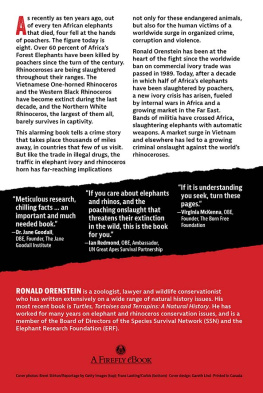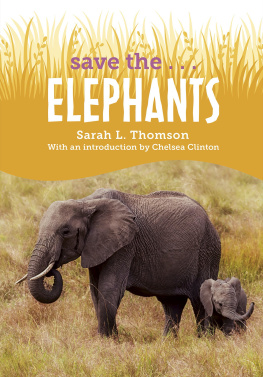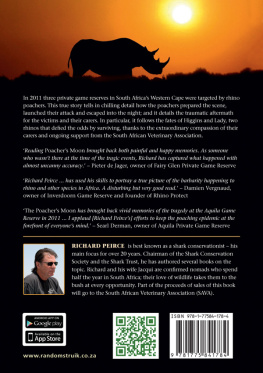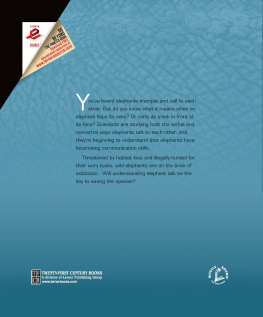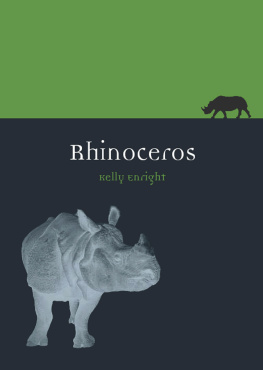FOREWORD
by Iain Douglas-Hamilton, OBE
As Ron Orensteins book goes to press the killing of elephants in Africa for ivory has intensified to new heights. Elephants are fewer in number than they were in the previous ivory crisis of the 1970s and 1980s. I have never witnessed such a demand for ivory in the 48 years I have studied them. The prices for ivory to the poacher and, in ever increasing increments, to the final buyers in the Far East exceed all previous records. Demand for ivory is driving the illegal killing and exceeds all possible supply. If demand is not reduced the elephants will be largely eradicated.
Already populations have been exterminated in places like Comoe National Park in the Ivory Coast and in the Affole Mountains of Mauritania, both of which had thriving elephant populations when I started the first Pan-African Elephant Survey in 1975. There has been a horrific roll call of incidents in the last few years. Bouba NDjida in Northern Cameroon was attacked by horsemen from Sudan allied to the notorious Janjaweed, and half the elephants were killed in a few days. Minkebe National Park in Gabon lost 11,000 elephants, Tsavo, Samburu and Mara are under attack in Kenya, and in East Africa nine out of ten populations are in decline. The Central African Forest Elephants have lost 62 percent of their numbers in one decade. All of this and far more is recorded in papers, reports and scientific publications.
The sheer weight of the destruction is overwhelming, but the statistics give no idea of the individual suffering, wounding and bereavement that accompany them. The rhino situation is even worse, with far higher prices for rhino horn and escalating killing in what formerly were the most secure havens. For these species to survive we need champions to tackle the poaching on the ground, to lower the demand, and like Ron to fight in the high corridors of power, at treaties like CITES, for political will and for united international action to counter these disasters.
Ron is one of those Westerners who care deeply for elephants and rhinos that still live somewhere out there, far away on other continents. Where Ron is exceptional is that he has made it a lifetime mission to secure their future with the skills he has at his command, an eloquent, tireless and legally encyclopedic knowledge. Those who ask the question What can I do to help? should read his book and learn of the endeavors of so many highly motivated conservationists. The future of these endangered creatures is often decided by policies forged in the remote assemblies of CITES, far from flesh and blood struggles. Though Ron has experienced the dust of the field he is known as a redoubtable warrior, always on the side of the animals, within the halls of the CITES Conferences of the Parties, where the rules are hammered out that determine how species may survive the relentless international and often criminal trade.
As a bewildered field person arriving at CITES for the first time I first met Ron as a guiding hand on the floor of a debate of CITES CoP 1987, and for many Conferences since. He is an unfailing source of legal advice in the labyrinthine complexities of this huge living, working treaty that has to cater to so many endangered species and conflicting human responses.
As Rons book goes to press at this crucial time, it will help people understand the history, background and current situation of elephants and rhinos. Ron is helping arouse the world to understand how we can secure a future for these species. Their fate is in human hands. The policies we adopt to save wildlife are generated from our sentiment and our understanding of the facts. We are the ultimate destroyers or guardians of wild creatures existence. Rons book tell stories of how we can save them.
Iain Douglas-Hamilton, OBE
Samburu, Kenya
March 2013
INTRODUCTION
For the worst possible reasons, elephants and rhinoceroses are front-page news today. From symbols of their ecosystems and magnificent standard-bearers for conservation they have become poster children for the worst excesses of organized wildlife crime. Horrifying stories of the current poaching crisis and the illegal trade that feeds on it have appeared in the New York Times and National Geographic, and on the BBC and the Australian Broadcasting Network.
The present crisis is the outcome of some 40 years of history, some of it acted out in nature and some in the debating halls of international politics. This book is an attempt to take you through that history, to explain how we and the animals got into this mess, and to suggest some ways to get out of it.
My own work, and my role in this story, has been away from the field, at international meetings where the rules that may decide the fate of both rhinos and elephants are fought over, seemingly endlessly. The inspiration for my work, though, has come from moments in the elephants and rhinos world. I have wandered close to wild African Savanna Elephants, who warned me away with outstretched ears and lowered trunks. I have ridden on the back of an Asian Elephant into the terai grasslands of Nepals Chitwan National Park, where I came face to face with a Greater One-horned Rhinoceros. I have floated close to Pygmy Elephants in a longboat on Borneos Kinabatangan River, and I have shared a cup of tea with the remarkable Dame Daphne Sheldrick on her front porch as her orphaned baby elephants gamboled on the lawn below me. I have walked almost up to placid Southern White Rhinoceroses in South Africa, and been chased by a Black Rhinoceros (fortunately I was in a vehicle at the time).
One of the problems in writing a book of this kind from a desk in Canada, far from the scene of much of the action, is that accurate information about illegal activities in remote and, often, dangerous places can be hard to find. In many cases it may not exist. Sometimes the people who know are too frightened to speak out. In March 2012, the IUCN African Elephant Specialist Group (AfESG) sent out a questionnaire on poaching levels and dynamics to elephant researchers and managers across Africa, but more than half of the respondents asked not to be named or quoted.
Peer-reviewed studies in recognized scientific journals probably provide the best source of accurate, unbiased data. Unfortunately, they take time to write, review and publish. Information from the scientific literature is rarely available for the most recent events.
Stories in the news media contain mistakes or exaggerations, contradict each other in reporting the same event, and may miss crucial points. Government reports may be self-serving, particularly if issues such as incompetence, mismanagement or corruption are involved. International bodies such as the Convention on International Trade in Endangered Species of Wild Fauna and Flora (CITES) are dependent on governments for their information, and their own reports may suffer in consequence.
Non-governmental organizations (NGOs) are often in a better position to get the real story. They may have considerable expertise at their disposal. Some send in their own investigative teams, often undercover, to talk directly to the actors and stakeholders on the ground. However, NGOs, most of which are activist organizations with strong views on what have become some of the most polarizing issues in the field of wildlife conservation, may have (or be accused of having) their own biases. These are often directly opposed to the biases of governments, which, in their turn, often vehemently deny the allegations NGO reports contain. China, for example, has suggested that NGO investigators may be mistaking carved pieces of mammoth ivory or resin (colophony) for elephant ivory.
In one recent case, a group of researchers studying ivory markets in Vietnam had to write a rebuttal to a press release announcing their own report. In their view, the release misrepresented their data by emphasizing high prices for a few items, leading other organizations to seize on these figures and claim trade values for ivory in Asia that were considerably higher than the analysis in fact showed. This sort of thing not only exaggerates a crisis but risks luring unscrupulous persons into the trade with the hope of even bigger profits than are, in fact, available. This is one of the reasons why I have been reluctant to quote more than a few estimates of market price for ivory or rhinoceros horn in this book, dramatic though those estimates may be.

